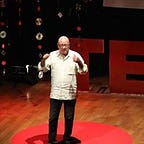What the World Needs Now Is More Great Minds Like Nobel laureate, Physicist Murray Gell-Mann
Dr. Bob Deutsch
As a cognitive neuroscientist who studies the mind, not the brain, it seems to me the debate about artificial intelligence has yet to focus on what is lost when we cede power to only to data and logic. And what is lost is the possibility of creativity and with it, art.
Artificial intelligence makes me yearn for the likes of Murray Gell-Mann; also Pablo Picasso, Leonard Bernstein, Zaha Hadid and George Carlin. Each of these individuals married their domain knowledge to beauty, bringing a unique rendering of complexity.
Sure, these admired experts knew the teachings of their respective domains, but to reach the interpretations and insights they will forever be remembered for they had to go passed the facts to construct metaphors, integrate paradoxes and each traveled their own path excavated by their personal feelings. These artful thinkers are the apple of our eye because they “think different.”
Without emotion — without feelings — there is no poetry to life. There is no warmth, just hard stochastic calculations. There is no individuality. With AI the aggregate is everything.
E.E. Cummings had it right when he wrote “Everyone can think or know, but not a single human being can be taught to feel. Why? Because whenever you think or know, you are a lot of other people…but the moment you feel, you’re nobody but yourself.” Jimi Hendrix concurred: “What matters is feeling. If only people would take more of a true view and think in terms of feeling. It’s your feelings that matter.”
As a child I grew up on the Upper West Side of New York, near Lincoln Center. I attended Leonard Bernstein’s “Young People’s Concerts.” He wasn’t directly teaching us kids how to conduct or compose; he was teaching us the majesty of feeling, of passion, of what it means to be in the music.
Reading about Dr. Gell-Mann’s work takes me back to those Bernstein concerts.
At Murray Gell-Mann’s death in May 2019, Sean Carroll wrote in The New York Times, “There are many ways to become an influential theoretical physicist. Some produce creative, new ideas, while others are masters of intricate calculations. Some are best at speculating about the unknown, while others bring clarity and insight to established lore. Part of what made Dr. Gell-Mann special was his mastery of all the modes.”
Interestingly, the qualities of mind that Gell-Mann was known for can be described by what the artist, Robert Rauschenberg, described as capabilities needed for creativity:
* Create your own path, don’t follow trends, break the rules (also said by Pharrell and Sting);
* Learn from everything and anything (a capacity embodied by the likes of David Bowie);
* Keep your mind open, not always needing to know the end at the beginning (as Feynman said, not knowing can be interesting and doubt can keep you honest);
* Use your body as material (see Albert Einstein on the “intuition of the body”, Princeton University, 1945; and the sound choreographer, Meredith Monk “Our bodies are our lives. We have them for a reason. They tell us things.”);
* Being right can stop the momentum of a very interesting idea; and make space for new mistakes (also expressed by the author, Philip Roth in his concept of “Anti-Fluency”).
It has also been noted that Dr. Gell-Mann spoke several languages and was interested in linguistics, archeology and natural history. This exemplifies what R.M. Rilke, in his “Blood Remembering,” said about creativity — that one needs to be familiar with many things, not just one thing. This is so because intuition often entails making connections between seemingly different things in order to make a new thing.
I had occasion to interview the jazz musician and composer, Wynton Marsalis. He has said, for example, that jazz is made up of “the raucousness of Saturday night and the piety of Sunday morning.” Merging opposites is often the way new things come into being. New things almost never arise from logic, objectivity and linear thinking.
Dr. Gell-Mann knew that “management” was the wrong concept to put creativity under. Creativity can’t be managed. Creativity comes when one is a witness to their mental activity and allows feelings of the moment to nudge them one way or the other. Creativity does not come from a linear, preprogrammed recipe or dictum: do A, then B, then C.
Life is not like sentences. Life doesn’t have periods. Creative mental activity meanders, it slides, twists and pole vaults Thoughts jump around and the distance they travel to sometimes connect with another thought is determined by their emotional connection.
I think Dr. Gell-Mann would have applauded if he was in the audience when the Kennedy Centers Honors had Jon Stewart open the ceremony honoring Bruce Springsteen. In Stewart’s preamble he said he “believes that Bob Dylan and James Brown had a baby, and that offspring was Bruce Springsteen.” It’s a good thing that an A.I. system wasn’t hired to write for the artful Stewart.
Viewing or listening to a product of artfulness, people can be moved to see the world within a slightly larger vision. Surely the world, nowadays, needs “feelers” more than just data scanners. Especially now, the world needs more people like Murray Gell-Mann.
